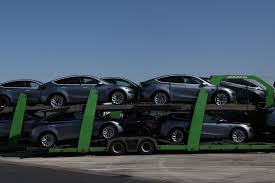In a surprising shift for the world’s most talked-about electric vehicle maker, Tesla delivery numbers for Q2 2025 are expected to fall significantly. Analysts project between 330,000 to 395,000 units delivered this quarter—down sharply from over 444,000 vehicles in Q2 2024. This decline in performance signals growing challenges for Tesla’s EV business, even as Elon Musk pivots focus toward AI innovation and the robotaxi rollout.
Tesla Delivery Numbers Signal Sales Slowdown
Tesla delivery numbers have become a key metric for investors and enthusiasts tracking the company’s growth. But in Q2 2025, those figures are painting a different picture. Forecasts across major analysts suggest a delivery shortfall of up to 25% compared to the same quarter last year. While the final number is expected to be released in the first week of July, early projections are already raising red flags.
What’s behind the drop in Tesla delivery numbers?
- Weaker demand in China and Europe, once Tesla’s fastest-growing markets.
- Rising competition from new EV brands, especially budget-friendly models with advanced features.
- Customer fatigue around older Tesla models like the Model 3 and Model Y.
- Musk’s polarizing public statements, which may be impacting brand perception in certain regions.
This slump marks Tesla’s second consecutive quarter of falling deliveries—a rare occurrence for a company that, until recently, saw exponential growth.
Key Point Summary
- Projected Q2 2025 Deliveries: 330,000–395,000
- Previous Year (Q2 2024): 444,000+
- Decline: Up to 25% year-over-year
- Top Challenges: Weak global demand, aging model lineup, and rising competition
- Analyst Concerns: Tesla needs 1M+ deliveries in H2 2025 to meet annual targets
Elon Musk’s Focus Shifts from Deliveries to Autonomy
While Tesla delivery numbers are under pressure, Elon Musk is emphasizing long-term innovation over immediate sales. The latest shift? A full-force move toward autonomous vehicles and artificial intelligence.
Here’s what’s happening:
- Tesla has launched a pilot robotaxi program in Austin, Texas, with select Model Ys providing autonomous rides under strict geofenced conditions.
- The company achieved a milestone autonomous delivery, with a driverless Model Y completing a full delivery route from the factory to a customer’s home.
- Musk is investing heavily in Tesla’s AI stack, moving away from traditional sensor-heavy approaches like LIDAR in favor of vision-only AI.
Despite some public safety concerns—such as inconsistent driving behavior in early robotaxi tests—Tesla is aggressively expanding the program.
For Musk, AI and robotaxi tech represent not just the future of Tesla, but a future where car ownership itself could become obsolete.
Tesla’s New Strategy: AI First, EV Sales Second?
With slipping Tesla delivery numbers, the company is making a bold bet. Instead of doubling down on boosting immediate sales, Tesla is investing heavily in autonomy, which Musk believes will become the company’s primary revenue source in the next few years.
Let’s break down the current strategy:
| Segment | Status in Q2 2025 | Future Outlook |
|---|---|---|
| EV Deliveries | Declining vs. 2024 | Needs product refresh |
| Robotaxi Program | Limited city testing | Scalable by 2026 |
| AI Development | Accelerating fast | Industry-leading edge |
| Stock Market Reaction | Cautiously optimistic | Volatile but bullish |
If successful, this pivot could make Tesla less dependent on physical car sales. However, the risk remains high. Scaling a robotaxi service comes with technical, legal, and public acceptance hurdles.
Can Tesla Recover Delivery Momentum?
Looking ahead, several questions will determine how Tesla performs in the coming months:
- Will a refreshed Model 3 or affordable new variant reignite demand?
- Can the robotaxi service expand without serious safety incidents?
- Will public perception shift as Tesla evolves into an AI-mobility company?
One thing is clear—Tesla delivery numbers are no longer the only metric defining success. Musk is asking investors and customers alike to buy into a broader vision: one driven by autonomy, not just acceleration.
Conclusion
As Q2 2025 closes, Tesla delivery numbers show a company at a turning point. EV sales are slowing, competition is heating up, and Tesla’s once-guaranteed growth engine is stalling. Yet, at the same time, Elon Musk is preparing for a world where robotaxis roam freely and AI runs the show.
Whether this pivot leads to renewed dominance—or deeper trouble—remains to be seen. But if one thing is certain, it’s that Tesla is once again refusing to play by the rules of the traditional auto industry.
Want to stay informed as Tesla reshapes the future of driving? Sign up for our weekly insights and never miss a shift in the EV and tech landscape.
